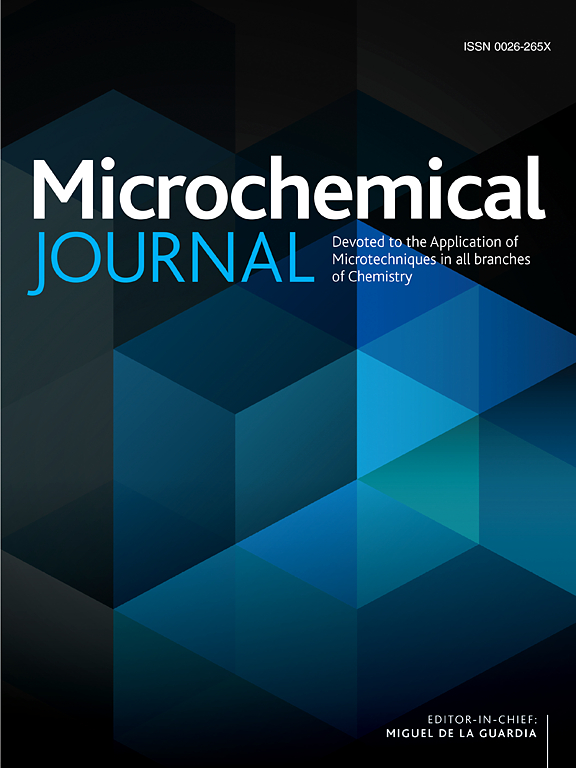Ultrasensitive multiplexed detection of cancer biomarker proteins using SPR imaging
IF 4.9
2区 化学
Q1 CHEMISTRY, ANALYTICAL
引用次数: 0
Abstract
While cancer is one of the leading causes of death worldwide, its diagnosis is still lagging behind lengthy procedures that are both expensive and lack specificity. Herein, we investigate the use of surface plasmon resonance imaging (SPRi) for the multiplexed detection of four cancer biomarkers associated with aggressive prostate cancer. This biomarker panel include prostate-specific antigen (PSA), insulin-like growth factor I (IGF-I), vascular endothelial growth factor (VEGF-D), and monocyte surface antigen (CD14). 16 spots SPR chip array functionalized with primary antibodies (Ab1) against the selected biomarkers, and bovine serum albumin (BSA) as a negative control, was housed in a 3D printed microfluidic channel to control the delivery of sample and reagents. Antigens were first captured, offline, on magnetic beads (MBs) labelled with secondary antibodies (Ab2), and SPRi signals were collected and analyzed while flowing the MBs on the chip. This enabled the collection of real-time data for the association between antigens, captured on MBs, and Ab1 immobilized on the SPR chip, and quantification of the target antigens after reaching equilibrium. This assay was capable of achieving dynamic ranges of 10 fg/mL to 100 pg/mL for PSA, 1 to 100 pg/mL for CD14, 1.1 to 110 pg/mL for IGF-I, and 0.5 to 100 pg/mL for VEGF-D. The multiplexed assay limit of detection (LOD) was found to 7.6 pg/mL for CD14, 5.8 pg/mL for IGF-1, and 5.3 pg/mL for VEGF-D with dynamic ranges of four orders of magnitude up to 125 pg/mL. While we could not apply this system in the analysis of real samples, it demonstrates a high throughput analytical approach with strong potential for identifying prostate cancer at an early stage. The system offers high sensitivity (down to few pg/mL) multiplexed detection of a selected panel of prostate cancer biomarkers.

利用SPR成像技术进行癌症生物标志物蛋白的超灵敏多路检测
虽然癌症是世界范围内导致死亡的主要原因之一,但其诊断仍然落后于冗长的程序,既昂贵又缺乏特异性。在此,我们研究了表面等离子体共振成像(SPRi)用于多路检测与侵袭性前列腺癌相关的四种癌症生物标志物。该生物标志物组包括前列腺特异性抗原(PSA)、胰岛素样生长因子I (IGF-I)、血管内皮生长因子(VEGF-D)和单核细胞表面抗原(CD14)。将16点SPR芯片阵列安置在3D打印的微流体通道中,以一抗(Ab1)和牛血清白蛋白(BSA)作为阴性对照,以控制样品和试剂的递送。首先在标记有二抗(Ab2)的磁珠(MBs)上脱机捕获抗原,并在芯片上流动MBs时收集和分析SPRi信号。这样就可以实时收集MBs上捕获的抗原与固定在SPR芯片上的Ab1之间的关联数据,并在达到平衡后对目标抗原进行量化。该试验能够实现PSA的动态范围为10 fg/mL至100 pg/mL, CD14的动态范围为1至100 pg/mL, IGF-I的动态范围为1.1至110 pg/mL, VEGF-D的动态范围为0.5至100 pg/mL。多重分析检测限(LOD)发现CD14为7.6 pg/mL, IGF-1为5.8 pg/mL, VEGF-D为5.3 pg/mL,动态范围为4个数量级,最高可达125 pg/mL。虽然我们无法将该系统应用于实际样品的分析,但它展示了一种高通量分析方法,具有在早期识别前列腺癌的强大潜力。该系统提供高灵敏度(低至几pg/mL)多路检测选定的一组前列腺癌生物标志物。
本文章由计算机程序翻译,如有差异,请以英文原文为准。
求助全文
约1分钟内获得全文
求助全文
来源期刊

Microchemical Journal
化学-分析化学
CiteScore
8.70
自引率
8.30%
发文量
1131
审稿时长
1.9 months
期刊介绍:
The Microchemical Journal is a peer reviewed journal devoted to all aspects and phases of analytical chemistry and chemical analysis. The Microchemical Journal publishes articles which are at the forefront of modern analytical chemistry and cover innovations in the techniques to the finest possible limits. This includes fundamental aspects, instrumentation, new developments, innovative and novel methods and applications including environmental and clinical field.
Traditional classical analytical methods such as spectrophotometry and titrimetry as well as established instrumentation methods such as flame and graphite furnace atomic absorption spectrometry, gas chromatography, and modified glassy or carbon electrode electrochemical methods will be considered, provided they show significant improvements and novelty compared to the established methods.
 求助内容:
求助内容: 应助结果提醒方式:
应助结果提醒方式:


